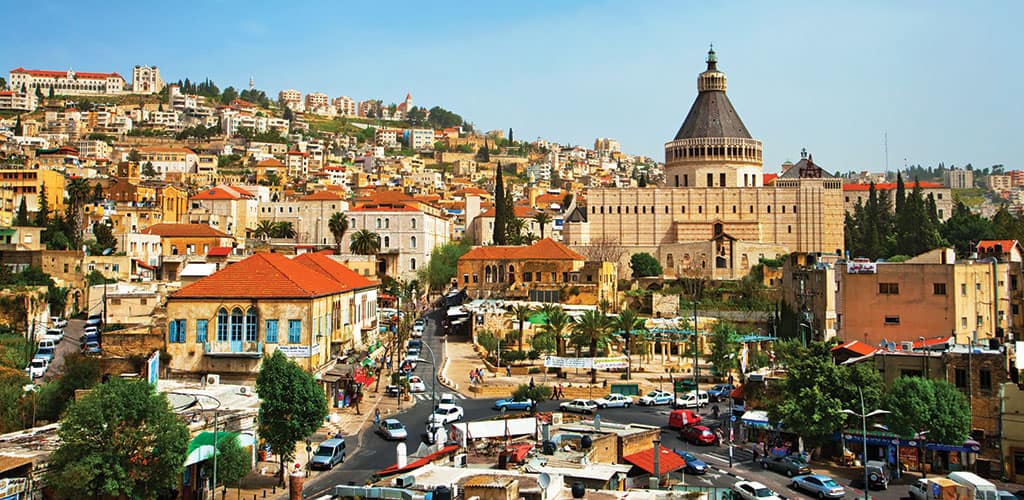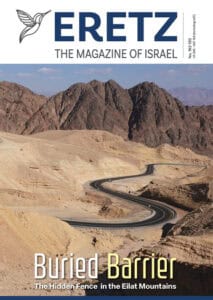
Noon in the Nazareth market, the largest open-air market in Israel. The two small tables at Abu Mahmoud’s coffee shop are full. A backgammon game is in full swing at one. At the other table, four card players are intensely focused on their hands. Water bubbles in the water pipes and thick black coffee residue coats the bottom of the traditional coffee cups – the little, handle-less porcelain cup known as a finjan in Arabic. The pleasant atmosphere quietly fills with that hint of suspicion that arises when members of different Israeli sectors meet.
“Tfadalu [welcome],” Abu Mahmoud says, inviting us inside with a wide smile that immediately breaks the ice.
The Tel Aviv members of our small group order bottled soft drinks from the refrigerator standing in the large domed room of the coffee shop. The veterans of many a trip around the country order coffee – black, freshly brewed, and spiced with cardamom from the market. We sit on cushioned benches along the wall and sip from the small porcelain cups.
“Are you from Nazareth?” we ask, the most banal of questions, yet a good opening line for many a conversation.
“Of course,” comes the answer from both tables.
We continue with the Hebrew catchphrase, Ma Hamazav? It literally means, “What is the situation?” but actually means, “How is everything with you?” leaving many options for an answer, from the personal to the general state of the Middle East. The silence in the room turns into a conversation.
“Nazareth is not a city,” our hosts explain. “It is a village, a village that has expanded, developed, and broken out in all directions. But at its base, it remains a village.”
And villages all over the world are the same. They have close-knit clans, historic feuds, and memories of forbidden love stories and sordid betrayals that go back for generations. In Nazareth, however, the feuds and love stories are between Muslims and Christians, Jews and Muslims, Christians and Jews, and all other possible combinations between the three faiths that believe in one God.
As a village, Nazareth’s fame spread around the world. This Galilean hamlet is where the Holy Family lived. Here, the archangel Gabriel announced to the young Mary that she was about to give birth to a son. The father of the boy was not her husband Joseph, but the Holy Spirit. History did not record what the wagging tongues of the village had to say about this pregnancy. They may have mentioned that Joseph was not originally from Nazareth. He had come there from afar, from Bethlehem in Judea. It is unclear what brought Joseph to Nazareth during the last years of Herod’s reign. The elderly king was about to die and winds of a dynastic battle and popular uprising were in the air. Maybe Joseph thought it was better to move to the countryside, to get away from the unrest brewing around Jerusalem.
Perhaps he came to seek work at the grand building projects of Herod Antipas, Herod’s son and the ruler of Galilee who was planning to build a new capital for the Galilee by renewing abandoned, destroyed Sepphoris on the great road trunk from Acre to Damascus. Sepphoris was less than three miles from Nazareth and would have attracted builders and carpenters as well as stonemasons from around the country. Joseph, who was a wood worker, would have found ample employment in the magnificent mansions going up in Sepphoris. What the young Jesus – then a popular shortened version of the name Joshua – did in his early years in Nazareth is unknown. Maybe he accompanied his father on the 40-minute walk to Sepphoris, where later traditions would place the home of Mary’s parents, and helped him with his work.
The scriptures and the early Christian historians have left very few details on Jesus’ life in Nazareth. However, once Christianity began to spread, in the second and third centuries CE, Nazareth began to attract increasing numbers of pilgrims, and the little hamlet in Galilee added pilgrimage to agriculture as a source of livelihood. Even though Christians make up the bulk of the tourists who come to Israel today and Nazareth is chock full of churches, monasteries, and other Christian sites, the city is not flourishing as a tourist destination. Tourists rush through it, staying for only a few hours on average, and then off they go to another destination in the Galilee.
As a Muslim city, Nazareth saw more success. During the eighteenth and nineteenth centuries, wealthy Arab families settled in the town and built large mansions in it – beautiful houses with painted ceilings and stucco ornamentation in the style of traditional Turkish-Lebanese architecture. During the final years of the Ottoman Empire and the British Mandate, Nazareth developed as the administrative and economic center of the Galilee, with the offices, services, and businesses that accompany a center of power.
The Israeli War of Independence and the first decades of the State of Israel were not kind to Nazareth. Refugees from the Arab villages of Galilee crowded into the town, settling in neighborhoods that became known by the names of the uprooted families’ villages. The new Israeli authorities looked on the town as a backwater for political dealings, creating a series of local Arab parties that mainly supported the leading labor parties that ruled Israel.
In 1956, following a plan to settle more Jews in the Galilee, land from Nazareth and the surrounding Arab villages was expropriated to create a Jewish town overlooking Nazareth, which was dubbed Nazerat Illit (Upper Nazareth).
Despite all this, Nazareth continued to grow and develop. Farming was no longer an option as much of its land had been expropriated, but the schools of the Christian organizations and institutions gave rise to an educated, professional population that supported itself very well in the modern economy of Israel by supplying professional, trade, and local government services. Meanwhile, the second and third generations of Israeli Arabs were learning how to demand their share of government funds and take their rightful place in the country’s political structure. Nazareth prospered and soon became the largest Arab city in Israel with a population of over 100,000.
Despite its fame worldwide, Nazareth remains an undiscovered travel destination. Its alleys are magical, filled with traditional workshops and ancient mansions. It boasts a unique and lively culinary scene, with some of the best restaurants and coffee shops in Israel. The walls of the monasteries and churches hide serene, beautiful gardens where nuns and monks have secluded themselves in order to seek peace and serenity in a world dedicated to faith and prayer. The painted ceilings adorning the mansions of the Old City artistically depict scenes from days long gone, while colorful, symbolic icons adorn its many churches, which represent an amazing variety of traditions. The Anglican Church looks as if it were transplanted from an old English parish. The mosques invite the visitor to rest in their carpeted prayer halls. Then there is the hummus. It is definitely the best in the country – ask all the bus and truck drivers from all over the country who make sure to stop at one of the many hummus eateries in Nazareth whenever they are in the Galilee.
This guide attempts to shine some light on the magic of this still unknown place. It is an invitation to the reader to stroll through the alleys, to venture away from the beaten path, and to spend the night.
As Abu Mahmoud greets visitor to his coffee shop, “Tfadalu,” and be enchanted by this very special place.


